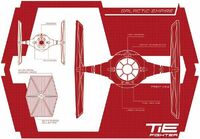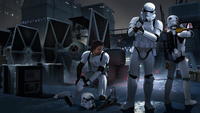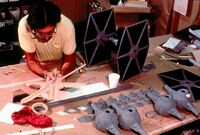| | |
Warning: This infobox has missing parameters: type and unrecognized parameters: class
- "You always hear them first. Twin ion engines make TIE fighters howl as they fly by on patrols."
- ―Ezra Bridger
The TIE/ln space superiority starfighter, also known as the TIE/LN starfighter and commonly called the TIE fighter, was the signature starfighter of the Galactic Empire and de facto symbol of Imperial space superiority. Its official production name was the Twin Ion Engine "line edition" space superiority starfighter.[4] Instantly recognizable from the roar of its engines as well as its unique design, the TIE/ln exuded Imperial power and prestige across the galaxy, seeing use throughout the Empire's political existence. They were nicknamed Evil-Eyes[10] or Eye-balls[29] by members of the New Republic.[10]
Characteristics
- "The standard TIE fighter is fast but flawed. No shields, no hyperdrive, and no life-support system reduces its mass for greater maneuverability. Has a pair of laser cannons mounted at the base of the cockpit."
- ―Antoc Merrick

Technical drawing of a TIE/ln starfighter
The TIE/ln starfighter was a small, short-range fighter developed, manufactured, and mass produced by Sienar Fleet Systems (SFS). Developed by SFS company head Raith Sienar,[2] the basis for the TIE fighter can be traced back to Kuat Systems Engineering's Alpha-3 Nimbus starfighter, along with several other outmoded models from the Old Republic.[4] Like their predecessors, TIE's employed two vertical wings similar in appearance to V-wing starfighters; however, the Eta-2 Actis-class light interceptor bore even more similarities with its central cockpit pod, twin ion engines and common weapons technology.[3]
The TIE/ln measured 7.24 meters in length,[4] and could attain a maximum speed of 1,200 kph.[7] It was propelled by two P-s3 ion engines, which would be replaced by twin P-s4 ion engines by approximately 14 BBY.[9] Pressurized fuel tankage was located on the underside of the cockpit.[4] TIEs were deployed from cycling racks that could contain a maximum of 72 craft.[30]

A Rebel T-65B X-wing starfighter in the sights of a TIE fighter's targeting computer
A TIE fighter's twin ion engines provided thrust and boosters capable of quickly adjusting the ship's direction. The TIE/ln featured vertical takeoff and landing (VTOL) capabilities owing to repulsorlift cyclers in its wing struts—reducing its already small mass to negligible weight—and micropositioning thrusts from the twin ion engines. Furthermore, the lack of a hyperdrive and resultant navigational systems alongside extended life support and fuel combined to cut down the TIE's total mass.[4]
In order to reduce the mass and energy consumption of the ship, the TIE lacked key systems such as deflector shields, hyperdrives or comprehensive life support. The lack of shields made the craft vulnerable to micro meteor impacts and combat damage hull breaches,[4] but these reduced facilities allowed the TIE/ln to be cheaply mass produced while also improving its maneuverability. Despite the lack of shielding, the starfighter's armored hull and transparisteel[source?] cockpit offered protection against hand-held blasters except in exposed areas such as the stabilizers.[31]
The fighter's black "wings" were in fact an array of twelve solar collectors that featured a micro-crenulated solar absorption surface.[4] From here, power would be pooled to the fighter's solar energy collection hub[4] and then to its twin ion engines and L-s1 low-temperature laser cannons capable of destroying a taylander shuttle in a single shot.[32][33]
Between the solar array and the main body of the craft was a stabilizer crucial to the fighter. Exposed from the hull armor, it could be exploited by a well-placed blaster-shot, causing the TIE to spiral off course and be set aflame, thus losing balance and lift if in atmosphere.
The lack of many essential systems, and therefore limited operational lifespan, doubled as theft prevention systems and deterrents for would-be defectors, but they were not the only countermeasure installed to prevent theft. Most TIEs were designed with a centrally controlled scuttling mechanism that would jettison the fighter's solar collector panels otherwise linked to the main body through a stabilizer,[source?] quickly disabling it.[34]
Its central cockpit was tightly fitted, incorporating flight controls, viewscreens, targeting systems, tracking equipment—including a homing beacon in case the vessel was stolen—and room for a pilot all in the central pod.[12] Despite being designed for a single occupant, several other passengers could fit inside the central cockpit, although the fit would be extremely tight.[12]
While TIE fighters featured minimal, perfunctory oxygen scrubbers and pressurized atmospheric seals, TIE pilots routinely wore full EVA suits owing to the ship's lack of full life support.
Flight controls were considered intuitive and easy to learn, in some cases allowing rebel novices to fly and operate them after having stolen them from Imperial airfields. TIEs were also outfitted with an ejector seat.[3]
During the reign of the Empire, TIE fighters were favored for their versatility, if not for their durability. They were able to operate both in space as well as in planetary atmospheres, acting as fighters or scouts.[35] They were more than capable of enforcing Imperial law against unarmed or lightly defended civilian transports. TIE/ln pilots were not afforded the independence enjoyed by equivalent pilots of the Rebel Alliance, as capital ships were preferred for tactical discussion among the Imperial Starfleet.[4]
At least a month after the Battle of Jakku, all TIE/ln starfighters were upgraded with advanced weaponry invented by Ved Foslo, allowing them to punch through an enemy fighter's shields as well as hull, destroying them in a single hit.[23]
History
Era of the Empire
- "The Emperor insists that the Imperial starfighters should be economical for mass production, and designed to make pilots simultaneously dedicated and compliant. And above all, the Emperor wants our starfighters to incite fear."
- ―Grand Moff Tarkin, in a memorandum to Raith Sienar
Following the transformation of the Galactic Republic into the authoritarian Galactic Empire, Republic era weapons and equipment would continue to be utilized throughout the Imperial sphere. As time went by, the Republic's Eta-2 Actis-class light interceptor and ARC-170 starfighters began to be phased out roughly five years after the proclamation of the New Order.[3] The Empire's regional Governor of the Outer Rim Territories, Grand Moff Wilhuff Tarkin, commissioned Sienar Fleet Systems to create a line of single-pilot, short-range starfighters for the Imperial Navy. Tarkin mandated that the weaponized fighters should be extremely fast and manuvarable, energy efficient, and inexpensive to manufacture.[6]
Raith Sienar personally designed the fighters, basing them off designs from the Star Courier, Alpha-3 Nimbus-class V-wing starfighter, and the Eta-2 Actis-class light interceptor. The result was a central spherical pod positioned between two hexogonal solar energy-collecting wings. To minimize power drain and maximize manuverability, Sienar eschewed typically standard systems such as deflector shields and a hyperdrive. After a series of test flights, the Empire approved Sienar's design, and executed an exclusive contract with Sienar for the production of TIE fighters.[6]

TIE fighters stationed at an Imperial airfield
With TIE pilots instructed to ignore their own well-being in order to achieve their objectives, the fighters were extremely fragile and their pilots expendable. With the Imperial Navy's vast size and unchallenged reign over the galaxy, the use of swarm tactics and subsequent mass production and refreshment of the vessels barely put a dent into Imperial manpower and industrial capacity. The low cost of production also spurred the craft's use.[4] As a result, many features were sacrificed to facilitate mass production by Sienar Fleet Systems factories. Wilhuff Tarkin, an excellent pilot in his own right, was known to think very poorly of the TIE fighter due to its cramped cockpit and seemingly disposable nature.[3][36] Imperial fighters also acted as psychological deterrents to potential seditious activities, with their roaring engines inspiring fear in those who heard them, leading to Imperial commanders to order their pilots to purposely fly low over areas that needed reminding of Imperial might.[23]
As part of the five-year plan for the industrialization of the Outer Rim Territories, TIE fighters were produced on a number of planets, including Lothal.[37] The Empire also gave some of its TIE fighters to loyalist companies to help secure its interests, leading to variants such as the Mining Guild TIE fighter.[32]
Rise of the Rebellion
While the Empire's rule was absolute for years,[38] rebels had begun to arise as early as a year into its reign[39] and an early rebellion against the Galactic Empire was waged. The Spectres fought Imperial forces, including TIE fighters, on Lothal[40] and later joined with the Phoenix Cell.[41] In 2 BBY,[42] Mon Mothma brought various rebel cells together as the Alliance to Restore the Republic.[43] While TIE fighters could engage unarmed and slightly defended civilian transports, they faced a more formidable foe in the form of the Alliance's starfighters.[4]
Following the destruction of the first Death Star, the classification between Army and Navy pilots—referred to as ground-hogs and vac-heads respectively—was rescinded, and the Imperial Military was to undergo a mass reorganization.[17]
After the Rebels hijacked the Imperial I-class Star Destroyer Harbinger, Luke Skywalker and Sana Starros use the stolen TIE fighters to patrol.[44]
TIE fighters on a Lothal airfield
Over time, a variety of other models arose from the TIE line, including notable vessels such as the TIE/IN interceptor, TIE/sa bomber, TIE/sk x1 experimental air superiority fighter, TIE/d "Defender" Multi-Role Starfighter and the TIE/rp Reaper attack lander, partly in direct response to faster and newer vessels manufactured by the Rebel Alliance. A variety of sub-models of the TIE line had arisen throughout Imperial history, with Sienar factories experimenting with localized improvements, producing advanced models suited to flying in local conditions and incorporating secret technological breakthroughs. Ships such as the TIE Advanced v1 fighter would see use by flight barons and high-ranking members of the Inquisitorius, however its extreme cost would later relegate its successor, the TIE Advanced x1, to be flown only by elite pilots and members of the Imperial hierarchy such as Lord Vader.[3] By the time of the Battle of Endor, TIE/IN Interceptors made up 20% of the Empire's starfighter fleet.[45]
Following the Battle of Endor, Imperial supply shortages would hinder the production and further development of TIE/ln starfighters, forcing Imperial-class Star Destroyers to make do with an inadequate number of ships and inexperienced pilots.[10]
Production data was classified, but according to numerous estimates, Sienar manufactured a minimum of approximately 4.6 million Imperial TIE fighters for Star Destroyers, other Imperial Naval vessels, and Imperial garrisons and defense stations. Most estimates maintain that more Imperial TIE fighters were operational at the same time than any other starfighter in history.[6]
Legacy
The legacy of the TIE fighter was not forgotten on the galactic stage, with Sienar Fleet System's successor, Sienar-Jaemus Fleet Systems, producing the latest-generation TIE fighters utilized by the Empire's successor state, the First Order. The TIE/sf space superiority fighter and TIE/fo space superiority fighter were a direct continuance of the imprint the TIE fighter had on galactic citizenry, and featured advanced weapons systems and a two-seated arrangement for use by the Order's Special Forces.[46]
Future historians would argue that flaws inherent in the TIE fighter design were allowed to remain, if only to increase the Empire's dependency on Sienar Fleet Systems for continued production of the craft, along with increased dependency on Kuat Drive Yards capital-scale carrier ships.[47]
Behind the scenes

TIE fighter models being constructed for A New Hope
Industrial Light & Magic's (ILM) Colin Cantwell created the concept model that established the TIE fighter's ball-cockpit and hexagonal-panels design for A New Hope.[48] Sound designer Ben Burtt created the distinctive TIE fighter sound effect by combining an elephant call with a car driving on wet pavement.[49]
The original TIE/ln fighters seen in A New Hope were relatively white, but were originally meant to have a maroon hull. One of the benefits of a slightly reddish color would have been that the fighter models would not have been as prone to "blue spill" as gray models were during filming against a blue screen. However, film composition tests revealed that the maroon ships blended too quickly into the mostly black star field when moving away from the camera, so a light gray was used instead.[50] The TIE fighter models featured in The Empire Strikes Back and Return of the Jedi were blue-gray.
Combat scenes between TIE fighters and the Millennium Falcon and Rebel Alliance X-wing fighters in A New Hope were meant to be reminiscent of World War II dogfight footage; editors used World War II air combat clips as placeholders while Industrial Light & Magic completed the movie's special effects.[51]
TIE/ln fighters are one of two starships available to Imperial players in Star Wars Battlefront, the other being the TIE/IN interceptor. Compared to the X-wings and A-wings, TIE fighters lack shields but instead possess good maneuverability and speed. However, their large wing panels make them very easy to hit in dogfights, giving Rebel fighters a slight advantage in ship-to-ship engagements.
Ultimate Star Wars stated that TIE fighters built on Lothal had shorter wings, as explanation for stylistic choices made for the TIE/ln's design in the animated series Star Wars Rebels. However, ![]() Rebels Recon: Inside "Always Two There Are" on StarWars.com (backup link) said that there is no difference. Since then, Pablo Hidalgo confirmed on Twitter that Ultimate Star Wars was incorrect.[52]
Rebels Recon: Inside "Always Two There Are" on StarWars.com (backup link) said that there is no difference. Since then, Pablo Hidalgo confirmed on Twitter that Ultimate Star Wars was incorrect.[52]
The reference book Star Wars: Rogue One: The Ultimate Visual Guide was the first reference book to identify the TIE fighter as the TIE/ln space superiority starfighter. It also defined the "ln" within the starfighter's name as standing for "line edition."[4]
Appearances
Non-canon appearances
- LEGO Star Wars Movie Short (2015 Episode 10: Rebels Raw Deal)
- Rogue One: Recon A Star Wars 360 Experience
- LEGO Star Wars: The Freemaker Adventures
- Disney Infinity 3.0
 LEGO Star Wars: All-Stars — "The Chase with Han/Escape with Chewbacca"
LEGO Star Wars: All-Stars — "The Chase with Han/Escape with Chewbacca"- Star Wars Resistance Racer
 LEGO Star Wars: All-Stars — "Dealing with Lando/Han and Chewie Strike Back"
LEGO Star Wars: All-Stars — "Dealing with Lando/Han and Chewie Strike Back"- The LEGO Star Wars Holiday Special
- LEGO Star Wars: The Skywalker Saga
Sources
Notes and references
Template:Galactic Empire starship classes


